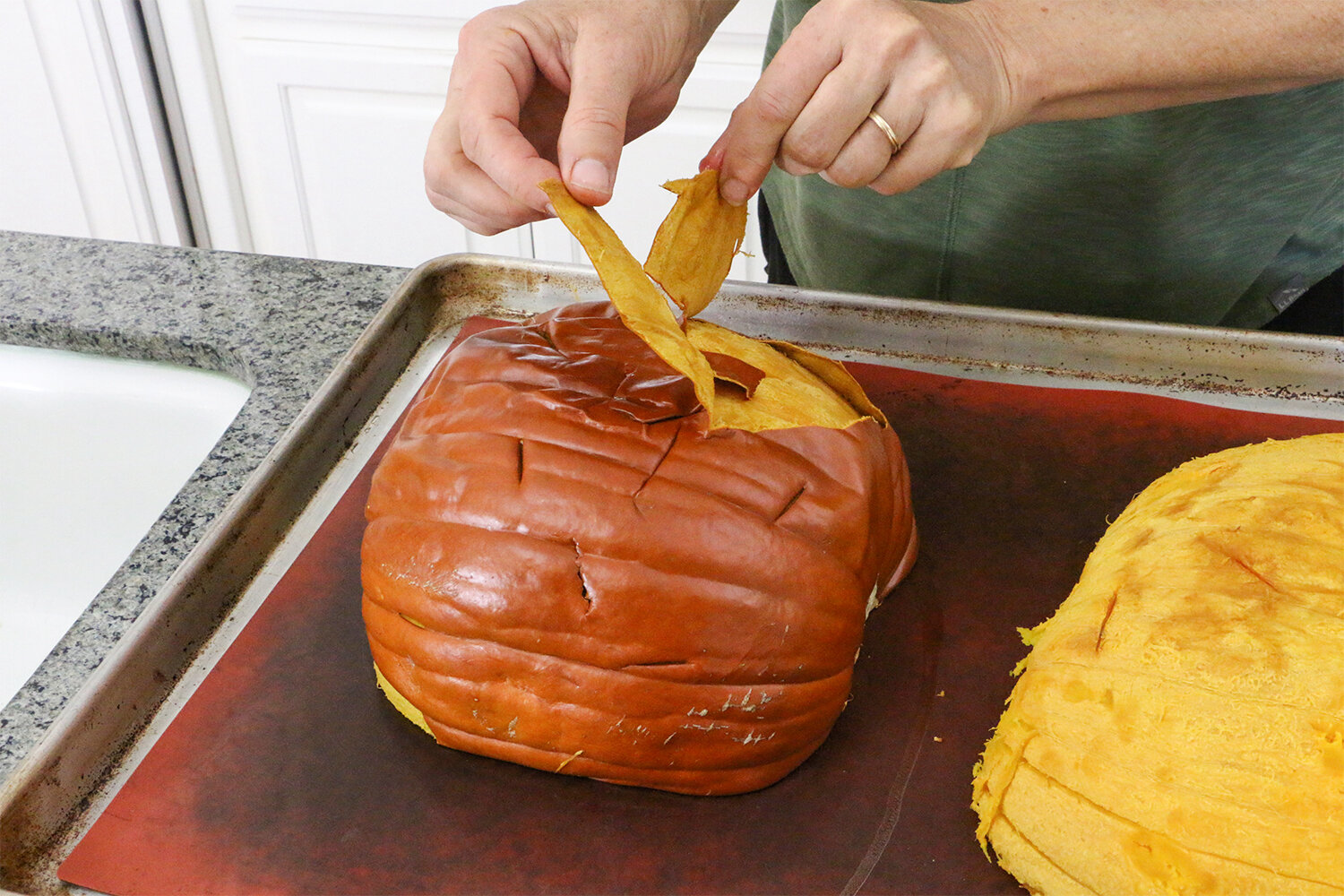Roasting a Whole Pumpkin (& Homemade Pumpkin Puree)
It’s officially Fall, and that means it’s time for all things pumpkin! The easiest and cheapest way to enjoy the fall flavors is to simply roast a whole pumpkin yourself, and it’s way simpler than you might think. You can use this pumpkin for soups, curries, or roasted veggie bowls, or blend it to make your own pumpkin puree for pies, muffins, and more! Not to mention, it’s a great way to use up your uncarved porch pumpkins at the end of the season.
ROASTED PUMPKIN’S ENVIRONMENTAL BENEFITS
By purchasing whole pumpkins, cooking on a Reusable Baking Mat, roasting the seeds, and composting the insides and skins, this recipe can be made completely ZERO WASTE
Buying locally grown and in-season produce significantly cuts down on the carbon emissions created during transportation
Cooking and eating seasonal pumpkin decorations is a great way to reduce food waste, as 1/3rd of the world’s food is wasted annually
Roasting a Whole Pumpkin (& Homemade Pumpkin Puree)
Prep Time: 20 Minutes
Total Time: 3 Hours
Ingredients:
- 1 Pumpkin (Sugar Pie or another orange variety) (see notes)
Optional:
- 1-2 Tbsp Olive Oil
- Salt & Pepper
- ½ - 1 cup Water
Instructions:
1. PREP: Gather a large cutting board, a sharp knife, and a large metal spoon, along with your pumpkin. Additionally, bring over your compost bucket or a bowl for collecting scraps or pumpkin seeds. Preheat your oven to 400°F (~205°C).
2. CUT: With the pumpkin standing upright, cut around the stem at the top and remove it. Then, cut the pumpkin in half from top to bottom. It’s okay if the halves aren’t perfectly even, this might impact the cooking times slightly (see notes).
3. SCOOP: Turn each half cut-side up, and begin scooping out the internal strings and seeds from the pumpkin. If you’re planning on roasting and eating the pumpkin seeds, separate them from the strings and set them aside. The strings can be placed into the compost.
4. BAKE: Take a sheet pan and line it with a Reusable Silicone Baking Mat. If you’re planning on eating the pumpkin with a savory dish, you can lightly brush the inside of pumpkin with some olive oil along with salt and pepper (skip this for pumpkin puree). Lay both halves of the pumpkin cut side down onto the mat, and with a knife, carefully poke 5-10 vent holes into the skin of each. Roast in the oven for 30-45 minutes, rotating halfway through the cooking time, or cook until a fork can easily pierce through the skin and pumpkin flesh with little resistance (it may take longer depending on the size of your pumpkin). If you’re planning to add the pumpkin to a dish, take it out of the oven earlier, when the knife still has a little resistance. That way, it can finish cooking with the rest of the dish. If you’re planning on pureeing the pumpkin, leave it in longer so that everything is very soft or even slightly overcooked.
5. PEEL: After removing from the oven, carefully flip the pumpkin halves over to allow the steam to escape (caution, they’ll be very hot). Allow the pumpkin halves to cool for about 30 minutes, or until cool enough to handle but still warm. At this point, start removing the skin of the pumpkin. It should peel off fairly easily, and any stuck bits of skin can be cut away. Once peeled, begin cutting your pumpkin into bitesize pieces (if adding to a dish) or larger chunks (if pureeing).
5. PUREE: For pumpkin puree, take your pumpkin chunks and add them to a blender or food processor (this may need to be done in multiple batches). Turn on your blender to begin pureeing the pumpkin, adding a Tablespoon of water at a time if needed, just enough to keep everything moving. Once smooth, you’re puree is ready to use! Add it into any recipe calling for pumpkin puree, or transfer it to an airtight container to use at a later date. Store the pumpkin in the fridge for up to 1 week, in the freezer for up to 6 months, or even can it for longer shelf preservation.
Notes:
Know Your Pumpkins – Before buying a pumpkin, check to see what variety you’ll want to cook with. There are tons of varieties, and you may not be able to taste it until it’s already cooked. Store bought pumpkin puree is typically made from Sugar Pumpkins, a sweeter variety of pumpkin, but the puree can be made with almost any internally orange variety. Larger carving pumpkins can be eaten (if uncarved), but they’ll likely have less meat inside than other varieties. White pumpkins can be eaten, but lack the signature pumpkin flavor, tasting more similar to cauliflower. Carved Jack-O'-Lanterns – While roasting is a great way to use up your uncarved pumpkins, you shouldn’t eat your carved jack-o'-lanterns. Opening and carving the pumpkin exposes it to the air and speeds up decaying, and you wouldn’t eat any other produce that’s been cut open and left outside for weeks. Check Both Halves — The best way to ensure that both halves of your pumpkin are cooked well is to check them both for doneness. Depending on their size or position in the oven, one may cook faster than the other. Try rotating the pan halfway through for even cooking. And if one half is done cooking before the other, remove it from the oven and allow the other half to continue cooking. Use Fall Decorations – You wouldn’t normally throw away perfectly good produce, so why throw out your decoration pumpkins after Fall? It’s so easy to cook them up and eat or puree them, and they make for some delicious zero waste decorations!

Did you make this recipe?
We love to see your pictures!
Tag @simple_ecology and hashtag it #simpleecology
© Simple Ecology













